Family : Cistaceae

Text © Prof. Paolo Grossoni

English translation by Mario Beltramini
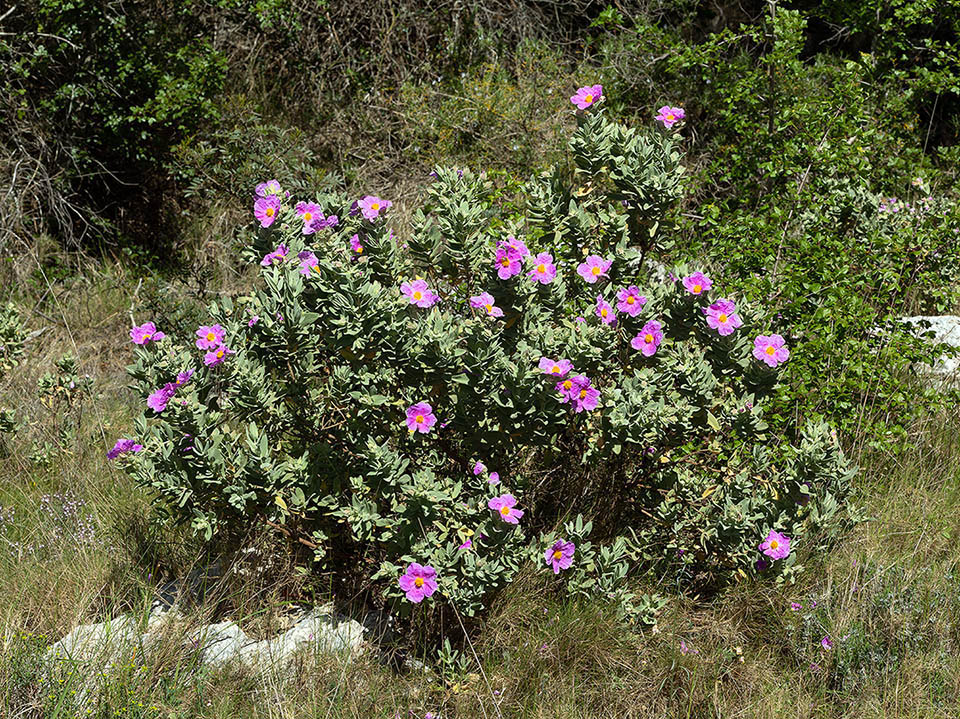
Cistus albidus, so called for the pale down of the leaves, is an evergreen shrub frequent in the limestone and arid soils of Mediterranean garrigue © Giuseppe Mazza
Due to the colour of the petals of the flower, the nurserymen have inserted Cistus albidus in the group ‘Purple Pink Clade’ (PPC) where are associated the rock-roses with the flowers of pink to purple pink colour.
This is a practical classification and not hierarchical-biological because the aggregation of these taxa done without relying on the evaluation of the morphological, metabolic and genetic distances between them does not allow to define the relationships of lineage nor even less, the rank of belonging.
Cistus albidus L. (1753), family Cistaceae Juss. (1789), genus Cistus L. (1753), owes its name to the whitish colour the twigs and the leaves of the year have.
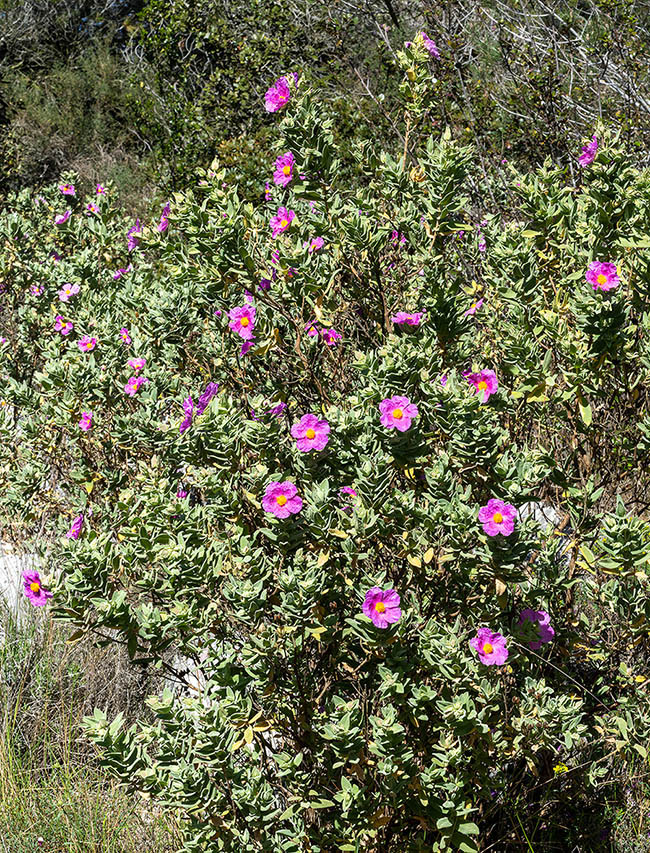
Can be even 1 m tall with persistent leaves arranged like a bottle brush and pink rose flowers © Giuseppe Mazza
It is commonly called cisto bianco, cisto biancastro, cisto a foglie sessili in Italian; grey-leaved cistus, spring rock-rose in English; Ciste cotonneux, ciste blanchâtre, ciste blanc in French; jara blanca in Spanish, roselha, roselha-grande, roselha-major in Portuguese and Weissliche Zistrose in German.
The gray-leaved cistus is an evergreen shrub, fragrant and small in size that may reach the height of about one metre.
The shrub is well branched and the single stems have the bark, of brown colour, detaching in longitudinal stripes.
It’s a fast growing plant, heliophilous and xerophilous, perfectly adapted to bright, warm and more or less arid environments.
Especially in the apical part, the small stems and their relevant leaves are covered by a thick white-greyish pubescence of woolly-looking appearance, hence the specific epithet and the common name present in several European languages.
The leaves are opposite, sessile and with enlarged base that at the insertion surround good part of the small stem (subamplexicaul leaves); the lamina is elliptical, 30-50 (60) mm long and less than half as wide and with the edges slightly revlute; the two paginae are covered by a dense greyish-whitish downiness.
The lower surface is grooved by 3 (5) prominent veins that run parallel.
The flowering takes place in spring, April to June. The flowers, in (3) 5-7 (8) groups of flowers on ramified definite growth inflorescences (where every branch ends with at least one flower), are inserted at the end of a robust peduncle more or less long (5-30mm) and, like the branchlets, densely pubescent.
They are quite showy: the corolla may reach the 60 mm of diametre whilst the petals, that begin to wither and fall already from the first evening, vary their colour from pink to purplish often with a yellowish spot towards the unguis.
Albeit not frequent, specimens can be found with white flowers (Cistus albidus f. albus (O.E. Warb.) Dans.).
The calyx is formed by 5 poijnted sepals, being the three outer ones bigger (10-15 mm) than the two inside and are covered by numerous stellate hairs and fall after the fruit has ripened.
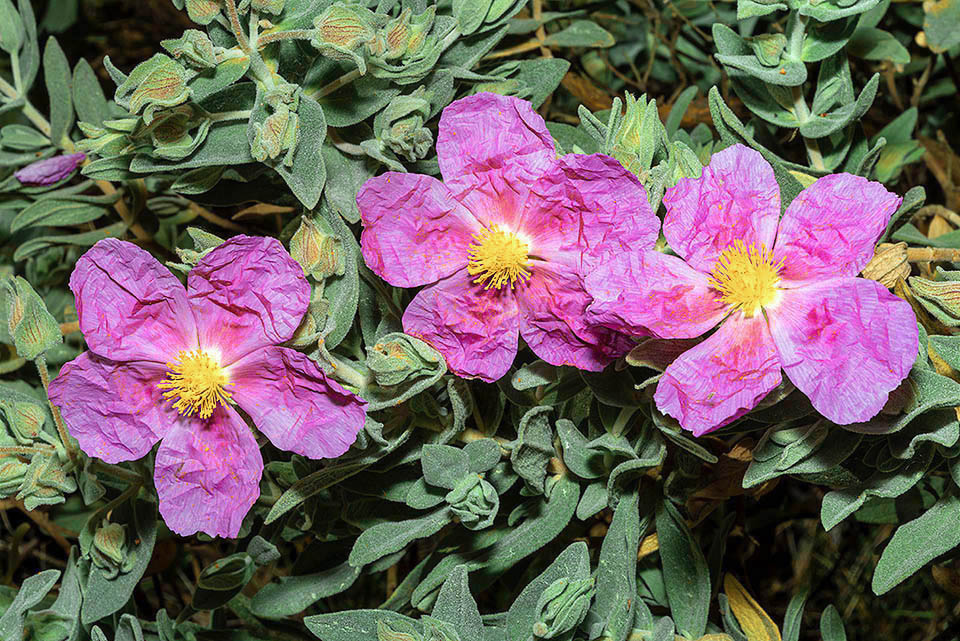
Even 6 cm broad, the flowers seem to be made with wrinkled paper. They are ephemeral but the rich spring blooming lasts till late June © Giuseppe Mazza
Like in the whole genus, the stamens are numerous; the style is just shorter than the stamens and ends in a stigma having five barely visible lobes.
The fruit is a loculicidal 7-13 mm long capsule covered by long and wiry hairs; it is divided in 5 chambers opening into as many valves that contain several small seeds (1-1,5 mm) brown-yellowish that, for germinating, need a thermal shock, of (80)-110 °C or a stay in the soil for several years.
Like in all cisti, the chromosomal number is 2n = 18.
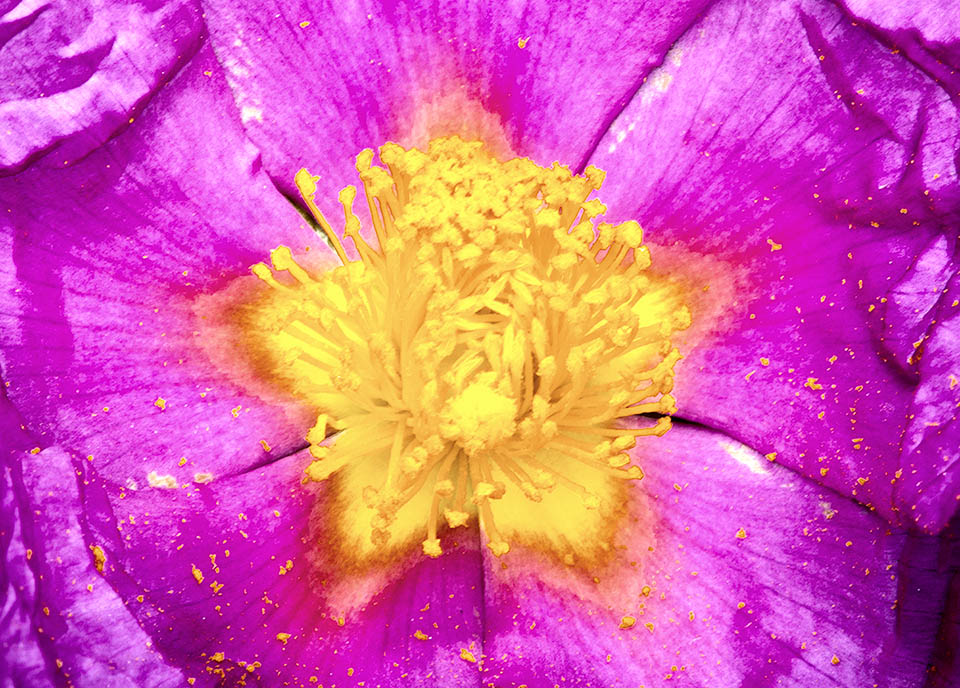
The flower’s receptacle of Cistus albidus seen from above, shows many stamens with anthers full of pollen and, almost alone the pistil. The petals display at the base a yellowish unguis and when visited by an insect, the stamens make way for it, moving to one side in order to leave uncovered the stigma as much as possible © G. Mazza
Its range includes north-western Africa (Algeria and Morocco) and south-western Europe (Iberian Peninsula, southern France, Balearic Islands, Corsica, Sardinia and central-northern Italy).
It grows on stony soils, mainly calcareous and arid, of the Mediterranean belts with prolonged summer drought being able to exceed the 1.000 (1.300) of altitude.
Being easily flammable, in the past it was employed to make bundles to use for starting the fire; nowadays it is employed in naturalistic engineering and is a good producer of pollen, but, mainly, is utilized as an ornamental plant.
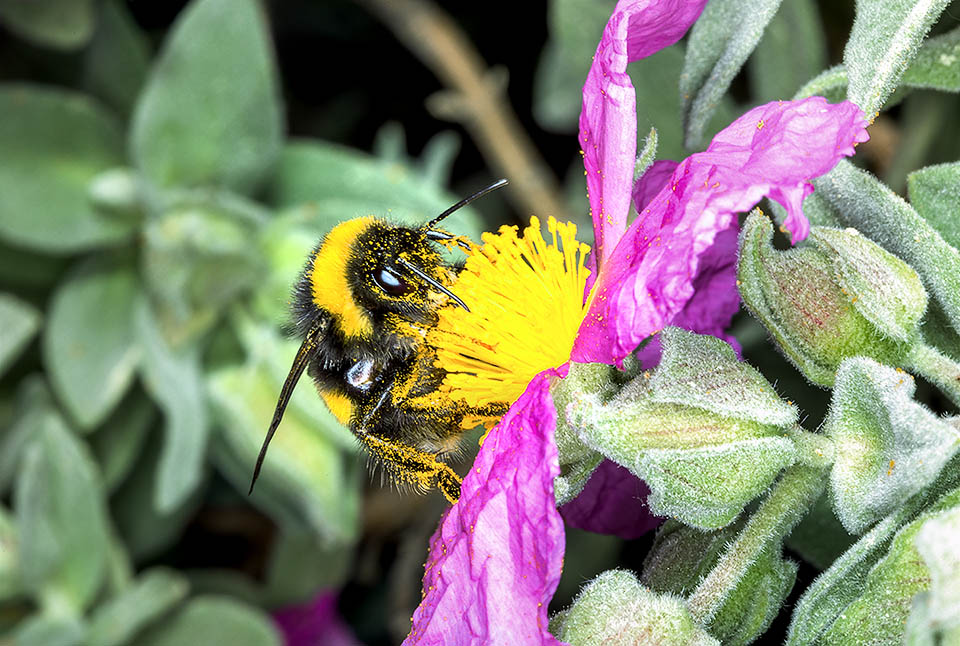
The petals fall already in the evening, and so the flowers feed the pollinators generously attracting bees and bumblebees, like this bumblebee © Giuseppe Mazza
Therefore, it serves for stabilizing the soils reducing the risk of erosions and for quickly recolonizing the soils after a fire, for the production of honey and, above all, in landscaping to create fences or to form groups or more or less ample mixed borders combining it with other shrubs, like other cistaceae, lamiaceae, legumes, composites, etc., of contained size, but with flowers, inflorescences or nice-looking leaves.
In the same manner of the other cisti, it may be multiplied by seed or by cutting.
As previously mentioned, the corolla is quite ephemeral. However, this fact has no particular consequences on the decorative effect because the blooming is abundant and being graded it may continue for a long time.
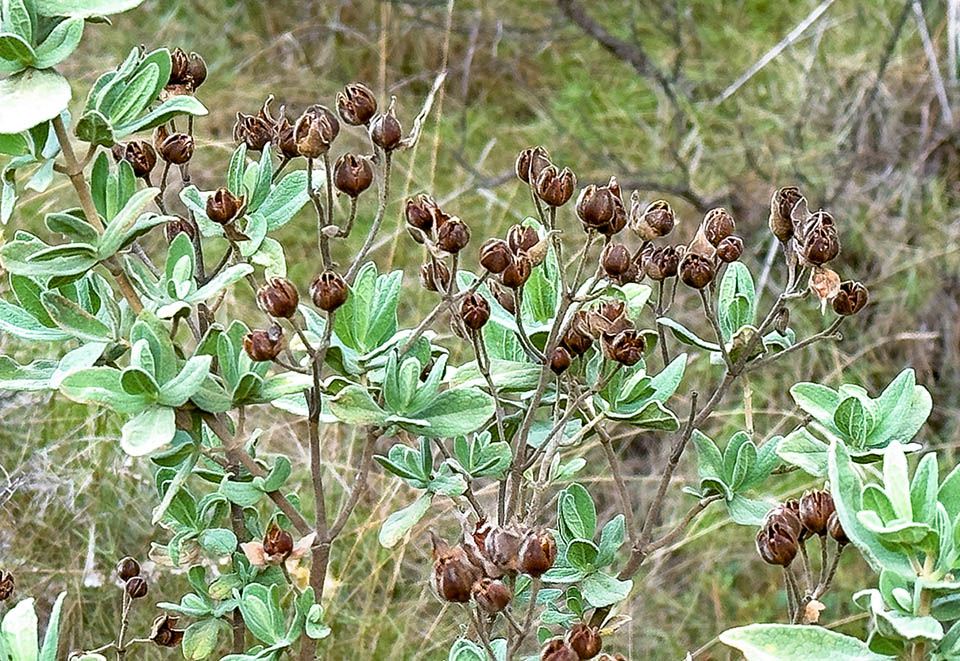
Ripe fruits at different opening stage, because the flowers of a same plant are often spaced out in their development © Giuseppe Mazza
Commercially, mainly for the colour of the flower, Cistus albidus is often mistaken with some varieties of Cistus creticus L. and of Cistus tauricus Presl.
The first too has young stems, leaves, peduncles and sepals densely hairy and pink petals tending to purple, at times with a more or less yellow unguis, but distinguishes from Cistus albidus because the leaf has an albeit short (3-15 mm) petiole but also this with enlarged base, moreover, the lower pagina displays an often very marked vein of pinnate-reticulate type.
The second cistus differs from the first only for the more intense colour of its colours and for the thick downiness of the capsules and, until a few years ago, was classified as sub-specific taxon thereo (either Cistus creticus subsp. eriocephalus (Viv.) Greuter & Burder or Cistus creticus var. tauricus (C.Presl.) Dunal). Still at the moment several are the floras that continue in granting this second cistus one of these two synonyms of Cistus creticus.
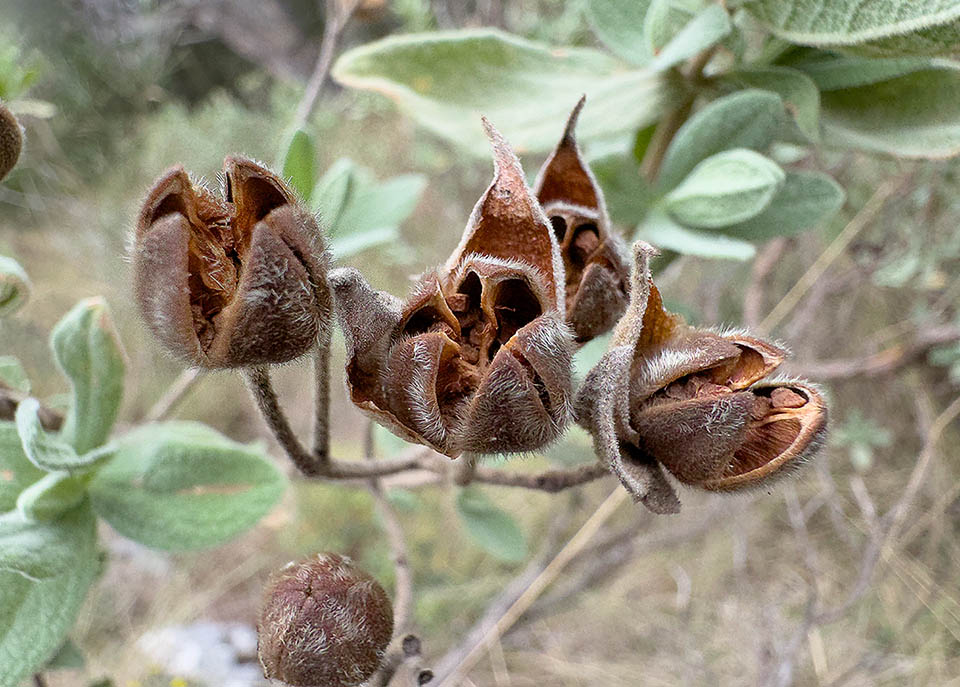
The fruit is a loculicidal capsule, 10-13 mm long, internally subdivided in 5 chambers opening into as many valves to disperse the tiny polygonal seeds © Giuseppe Mazza
Also Cistus albidus has been the subject of several denominations partially invalidated and partially accepted as synonyms. In this regard, “WFO World Flora Online” mentions 17 synonyms (WFO (2024)).
Are known several hybrids with other species of the genus such as: Cistus albidus L., Cistus chinamadensis Bañares & P. Romero, Cistus creticus L., Cistus crispus L., Cistus heterophyllus Desf. and Cistus ladanifer L.. A taxon, Cistus x gardianus Demoly, is considered as the outcome of more introgressions (triple hybrid: Cistus creticus, Cistus crispus and Cistus ladanifer).
Cistus × clausonii Font Quer & Maire (hybrid Cistus albidus × Cistus heterophyllus) is an endemism of north-western Africa. A few years ago, in south-eastern Spain were found some specimens initially referred to Cistus × clausonii but later on considered as a subspecies of the same: Cistus × clausonii nothosubsp. crespoi P.P.Ferrer & E.Laguna.
→ To appreciate the biodiversity within CISTACEAE family please click here.
